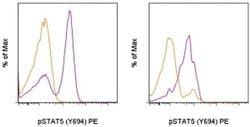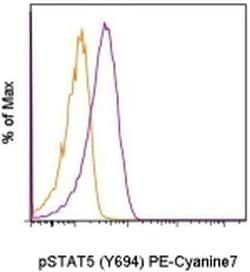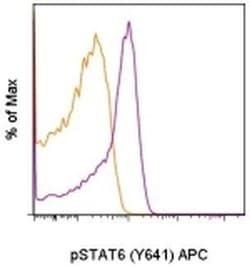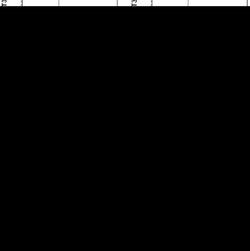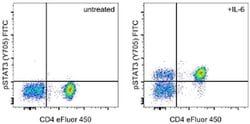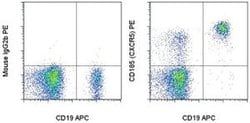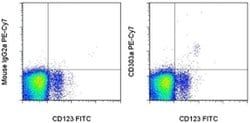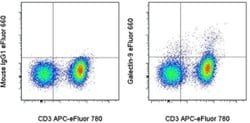Phospho-STAT5 (Tyr694) Monoclonal Antibody (SRBCZX), PE, eBioscience™, Invitrogen™
Manufacturer: Fischer Scientific
Select a Size
| Pack Size | SKU | Availability | Price |
|---|---|---|---|
| Each of 1 | 50-112-8658-Each-of-1 | In Stock | ₹ 35,333.00 |
50-112-8658 - Each of 1
In Stock
Quantity
1
Base Price: ₹ 35,333.00
GST (18%): ₹ 6,359.94
Total Price: ₹ 41,692.94
Antigen
Phospho-STAT5 (Tyr694)
Classification
Monoclonal
Concentration
5 μL/Test
Formulation
PBS with 0.2% BSA and 0.09% sodium azide; pH 7.2
Gene Accession No.
P42229, P42230
Gene Symbols
STAT5A
Purification Method
Affinity chromatography
Regulatory Status
RUO
Gene ID (Entrez)
20850, 6776
Content And Storage
4° C, store in dark, DO NOT FREEZE!
Form
Liquid
Applications
Flow Cytometry
Clone
SRBCZX
Conjugate
PE
Gene
STAT5A
Gene Alias
AA959963; mammary gland factor; mammary gland factor STAT5A; mammary gland factor; transcription factor; Mgf; Mpf; signal transducer and activator of transcription 5; signal transducer and activator of transcription 5a; signal transducer and activator of transcription factor 5A; STAT; STAT5; STAT5A; STAT5A, Mammary Gland Factor; STAT5A/MGF; STAT5B; STATA5
Host Species
Mouse
Quantity
100 Tests
Primary or Secondary
Primary
Target Species
Human, Mouse
Product Type
Antibody
Isotype
IgG1 κ
Description
- Description: This SRBCZX monoclonal antibody recognizes signal transducer and activator of transcription 5 (STAT5) when phosphorylated on tyrosine 694
- STAT proteins are activated by ligand binding to receptors, such as cytokine receptors, that associate with Janus kinase (JAK) family members
- Following their phosphorylation by JAKs, STAT proteins translocate to the nucleus where they bind to DNA and regulate transcription of specific genes in a cell type- and cytokine-specific manner
- In response to cytokines that signal through the common gamma chain such as IL-2, IL-7, and IL-15, STAT5 is phosphorylated on tyrosine 694 by JAK1 and JAK3
- Cytokines such as IL-3, IL-5, and GM-CSF that signal via the common beta chain induce STAT5 phosphorylation on tyrosine 694 by JAK 2
- Phosphorylation of STAT5 on tyrosine 694 is essential for STAT5 dimer formation, nuclear translocation, and DNA binding activity
- Specificity of this SRBCZX clone was determined by ELISA and flow cytometry
- Applications Reported: This SRBCZX antibody has been reported for use in intracellular staining followed by flow cytometric analysis
- Applications Tested: This SRBCZX antibody has been pre-titrated and tested by intracellular staining followed by flow cytometric analysis of stimulated normal human peripheral blood cells
- This can be used at 5 μL (0.25 μg) per test
- STAT5 alpha is a member of the STAT family of transcription factors
- In response to cytokines and growth factors, STAT family members are phosphorylated by the receptor associated kinases, and then form homo- or heterodimers that translocate to the cell nucleus where they act as transcription activators
- STAT5 alpha is activated by, and mediates the responses of many cell ligands, such as IL2, IL3, IL7 GM-CSF, erythropoietin, thrombopoietin, and different growth hormones
- Activation of STAT5 alpha in myeloma and lymphoma associated with a TEL/JAK2 gene fusion is independent of cell stimulus and has been shown to be essential for the tumorigenesis
- The mouse counterpart of STAT5 alpha is found to induce the expression of BCL2L1/BCL-X(L), which suggests the antiapoptotic function of this protein in cells
- STAT5 alpha, along with STAT5 beta, were identified in mouse
- The amino acid sequences of STAT5 alpha and STAT5 beta show 96% sequence similarity, and both proteins are co expressed in most tissues in virgin and lactating mice
- However, differential accumulation of STAT5 alpha and STAT5 beta mRNA has been reported for both muscle and mammary tissue
- STAT5 alpha is critically involved in a variety of physiological functions, including reproduction, lactation, immune function and somatic growth.
